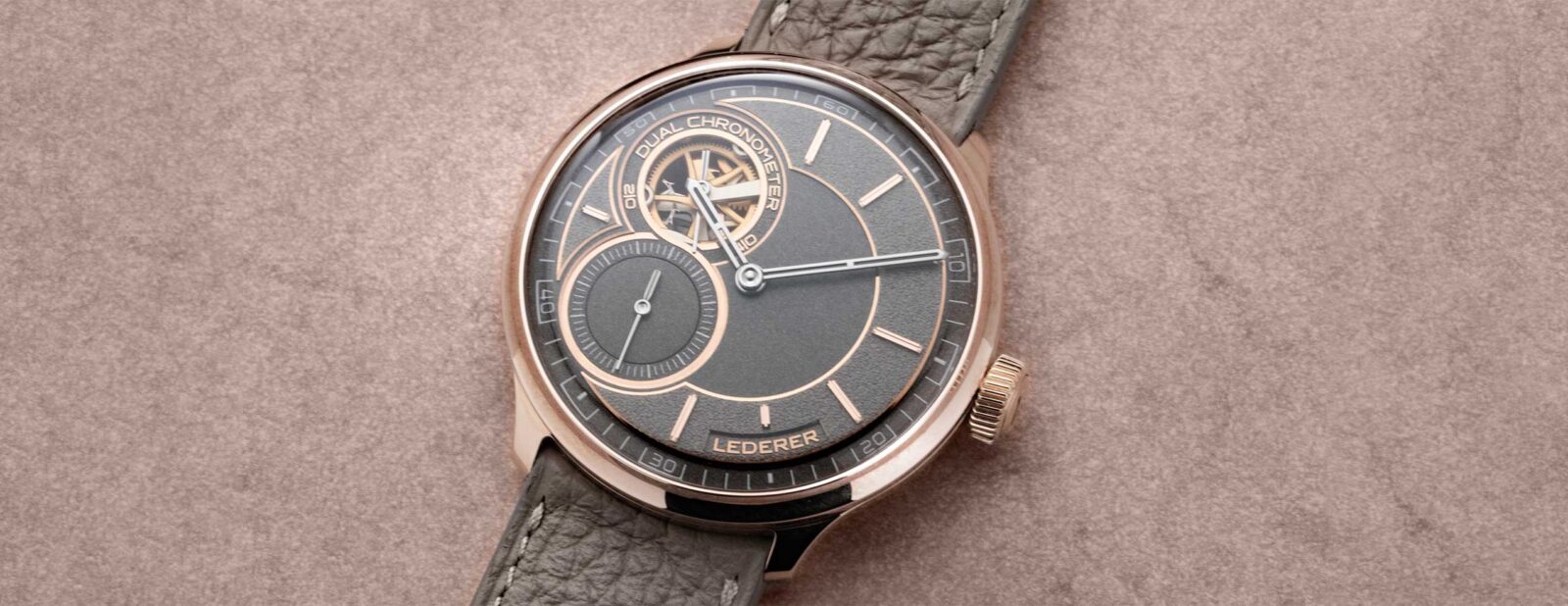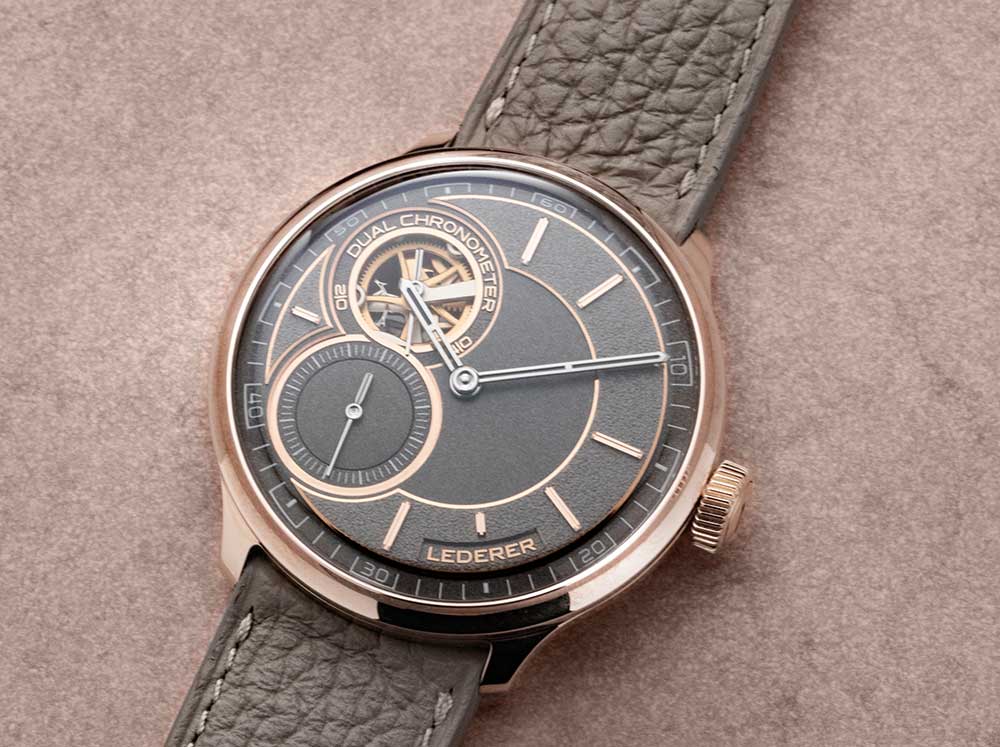News
A Closer Look: Bernhard Lederer Central Impulse Chronometer 39mm
Watches & Wonders 2024 saw the release of numerous mega complications and record setters but what is arguably even more unusual than any of those is the downsizing of a movement that is equipped with one of the most complex and efficient escapements. The independent double wheel escapement., where each escape wheel requires its own complete gear train and power source, led many a great watchmaker to believe that such a movement could not be sufficiently miniaturized in a wristwatch. Against the odds, Bernhard Lederer has now introduced the Central Impulse Chronometer in a 39mm case, a significant reduction from its previous 44mm diameter, making it the smallest watch ever equipped with such an escapement.
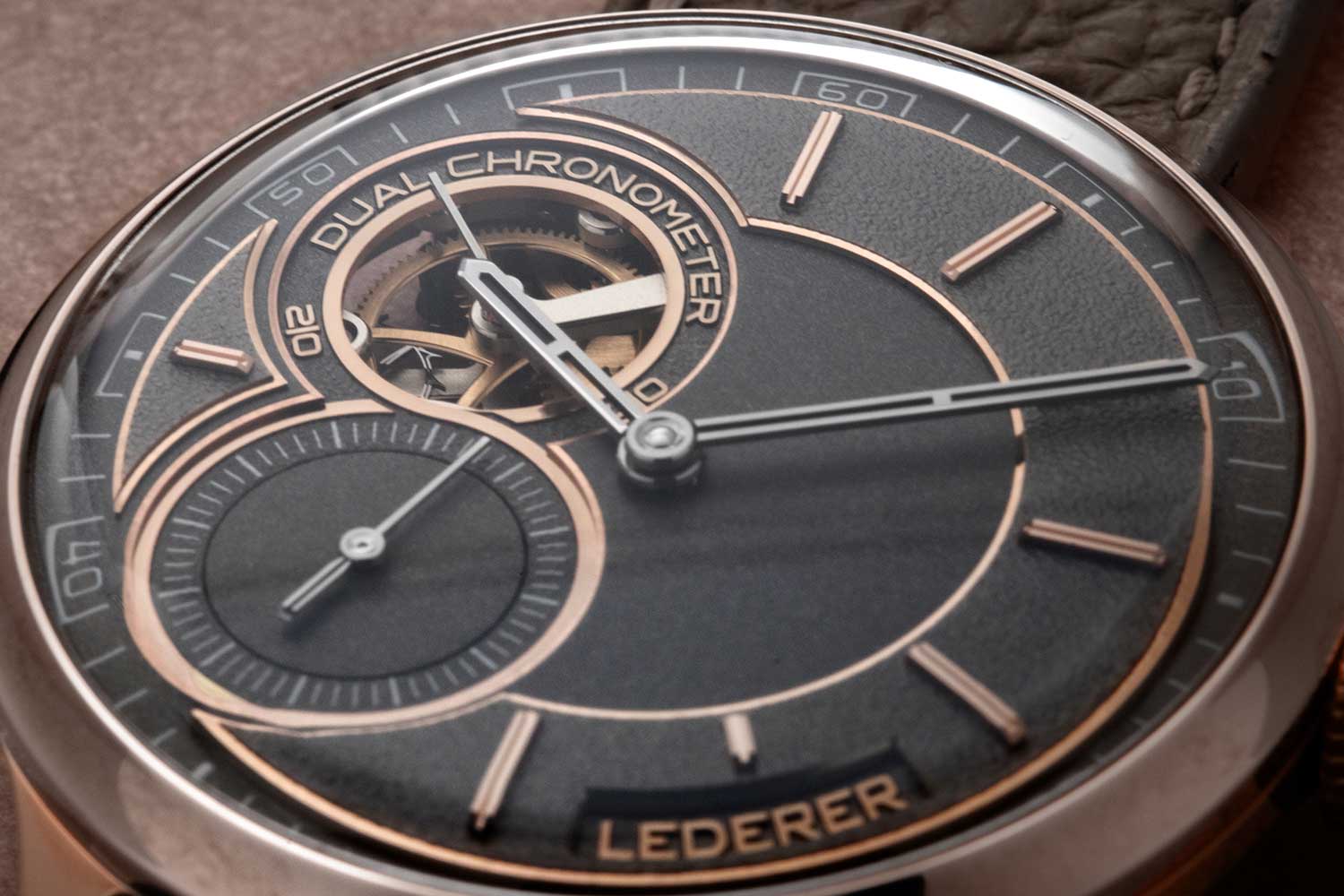
Bernhard Lederer Central Impulse Chronometer 39mm (Image: Revolution©️)
The independent double wheel escapement was invented by George Daniels to realise the merits of Breguet’s natural escapement – dual direct impulse at each oscillation – while addressing its weaknesses such as inertia or play. It differs from the Swiss lever and the Co-Axial in that both impulses are delivered directly to the balance wheel at each cycle while being more efficient than the natural escapement as each escape wheel is driven by its own gear train and mainspring.
Lederer’s version of the escapement, however, is technically unique. In contrast to the natural escapement or Daniels’ original independent double wheel design, it restarts more easily as the watch is wound. Additionally, the movement incorporates a remontoir along each gear train to provide an unvarying amount of torque to each escape wheel. The watch stands as one of the most intellectually and visually engaging high-grade chronometers today. And in a time when the degree of independence in independent watchmaking is increasingly blurred, the Central Impulse Chronometer is the work of an independent watchmaker in the authentic sense. The movement was conceived and developed by Lederer himself. With the exception of the case, crystals and springs, all components were produced in-house at his manufacture in Saint-Blaise.
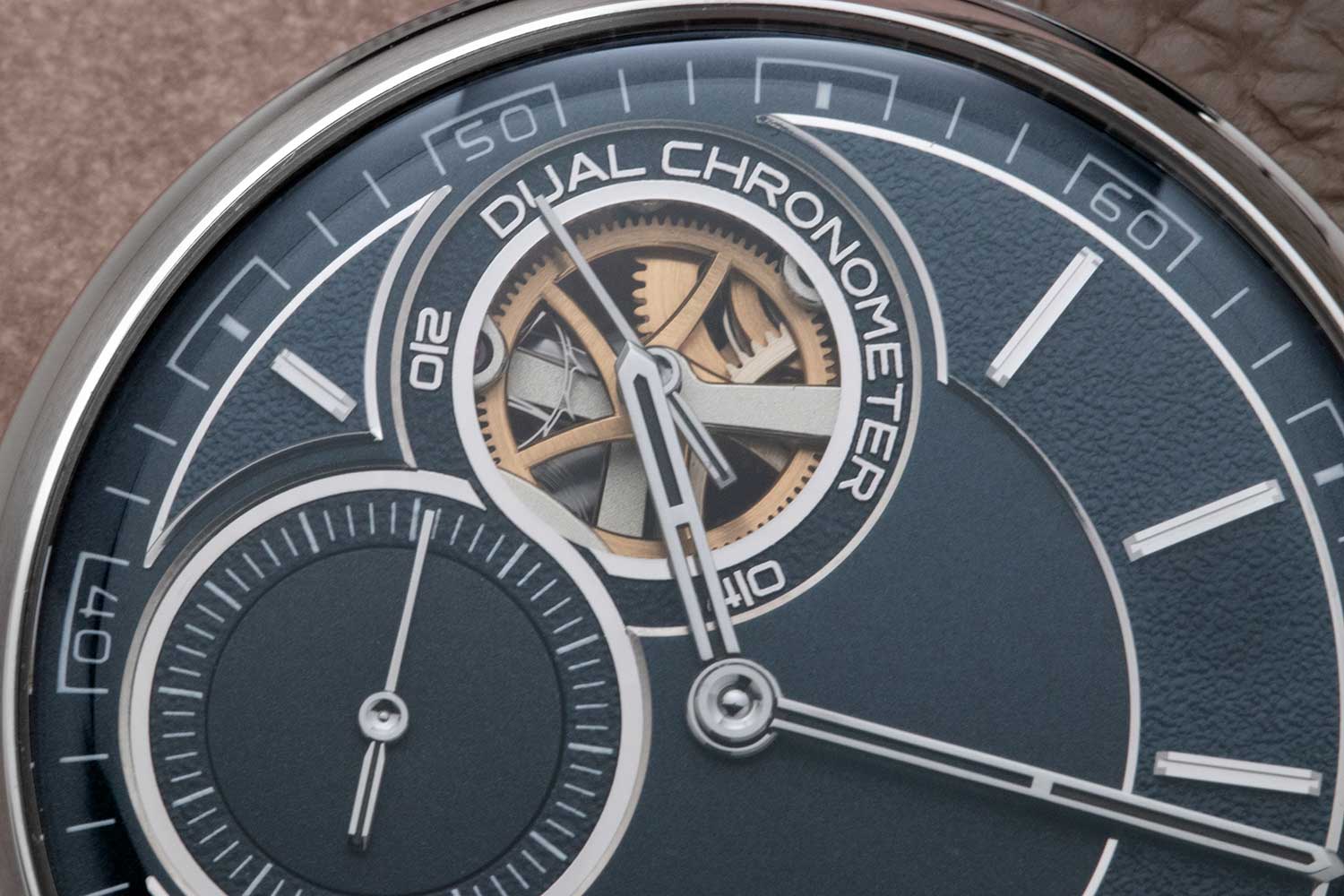
Bernhard Lederer Central Impulse Chronometer 39mm (Image: Revolution©️)
The Watchmaker
Lederer was born in 1958 in Kornwestheim, Germany, and was raised in the city of Stuttgart. He came of age during the Quartz crisis and completed his bachelor’s degree in watchmaking from a vocational school in Düsseldorf in 1979 followed by a master’s degree in watchmaking from a goldsmith and watchmaking school in Pforzheim in 1984. His thirst for knowledge led him to London in the early 1980s, where he and his younger brother hitchhiked to buy a copy of Daniels’s book Watchmaking, which he couldn’t find locally. In 1984, Lederer opened his first business, Uhrenmanufaktur Lederer, specializing in restoring vintage watches and clocks, but he quickly transitioned to making his own. He completed his first clock in 1986: a secular perpetual calendar table clock with a moon phase accuracy of a day’s error in 800 years. It captured Daniels’s attention at Basel World, who encouraged him to create his own wristwatches.
In 2000, Lederer moved to Switzerland to focus on his own watch brand, BLU. He sold the brand in 2009 but he bought it back a year ago. Today, along with his wife Ewa, he runs Manufacture de Haute Horlogerie et Micromécanique (MHM), which employs over 25 people. The manufacture develops movements and produces watch parts for other brands apart from his own.
The Central Impulse Chronometer which debuted in 2021 is the first in a series of watches dedicated to unusual and innovative escapements. Two 44mm limited editions in white gold, followed by rose gold and steel have been produced so far. This was followed by the Central Impulse Chronometer InVerto last year which showcased the astonishing movement on the dial.
Phenomenally compact
With the new model, the objective was not only to reduce the diameter of the movement but also to decrease its height to preserve the overall proportions. It measures 35mm wide and just 4.95mm high. When cased up, the watch measures 39mm by 10.75mm versus 44mm by 12.2mm before. It is available in white gold with a blue dial or rose gold with a grey dial, each limited to 20 pieces.
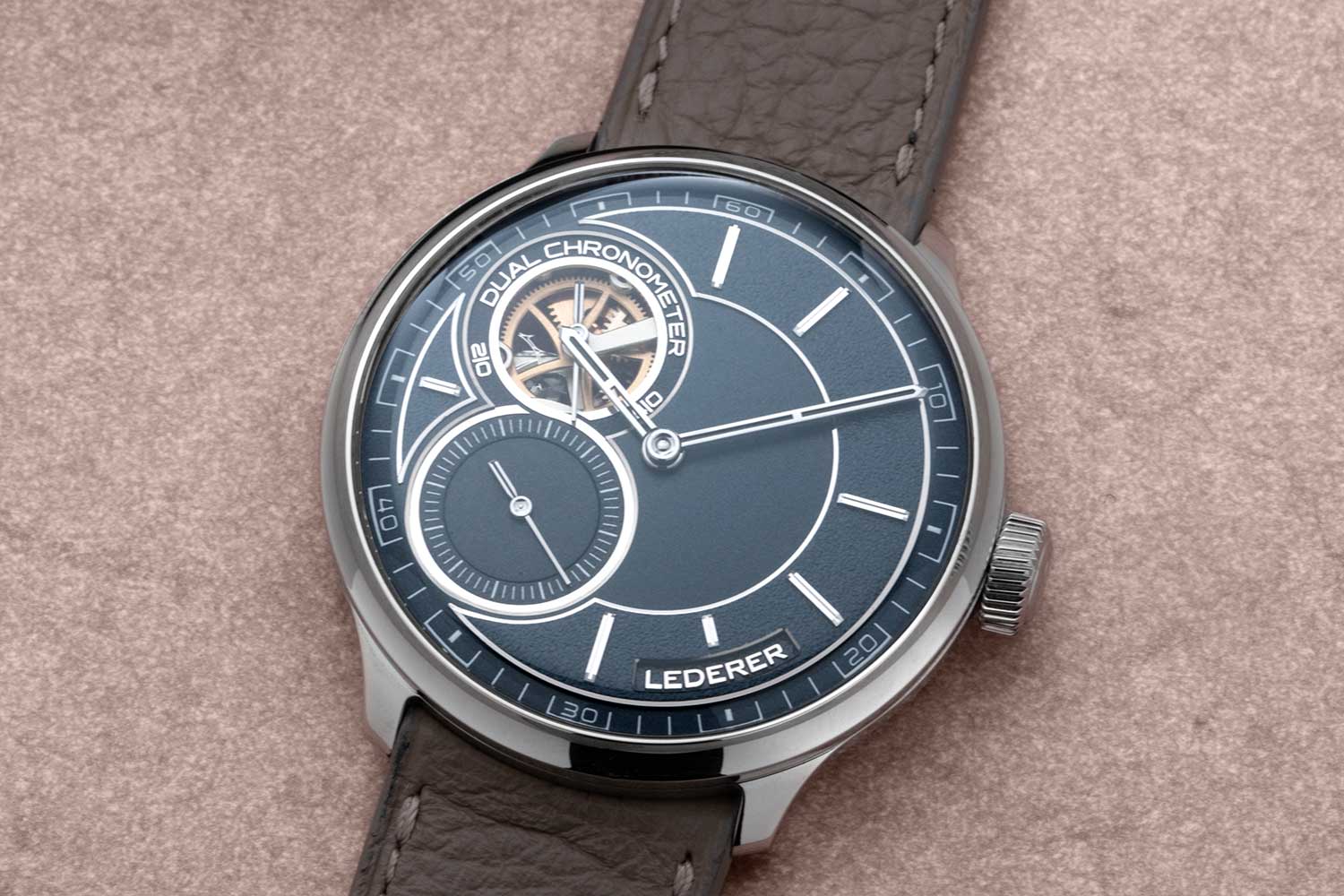
Bernhard Lederer Central Impulse Chronometer 39mm (Image: Revolution©️)
The design of the dial has been significantly refined. Produced entirely in-house, it is very elaborate, consisting of three layers. Featuring a grené finish, it includes a raised chapter ring with applied gold indices. The five-minute numerals and markers are framed in a manner that adds a subtle dynamism to the overall design. The small-seconds subdials are recessed with the lettering and numerals engraved in relief. Unlike the previous model, only one seconds sub-dial is openworked to reveal the fourth wheel beneath; the other is closed for better readability, resulting in a more refined design overall. Quite clearly, the dial has been sensitively conceived and all the various elements combine to produce a stronger, more distinctive design language.
Turning the watch over, the movement is noticeably denser. Its overall layout has been preserved, but the clearances have been reduced. Everything has been condensed without seeming congested, effectively highlighting the geometry of the two independent going trains and clearly displaying the functions of the individual components. Naturally, the size of the mainspring barrels had to be reduced; they offer a power reserve of 38 hours compared to the previous 42 hours while the balance maintains a frequency of 3Hz. Lederer explains that the entire hand-setting and intermediate winding mechanism had to be redesigned and reconstructed. Additionally, it now incorporates a stop-seconds function for precise time-setting.
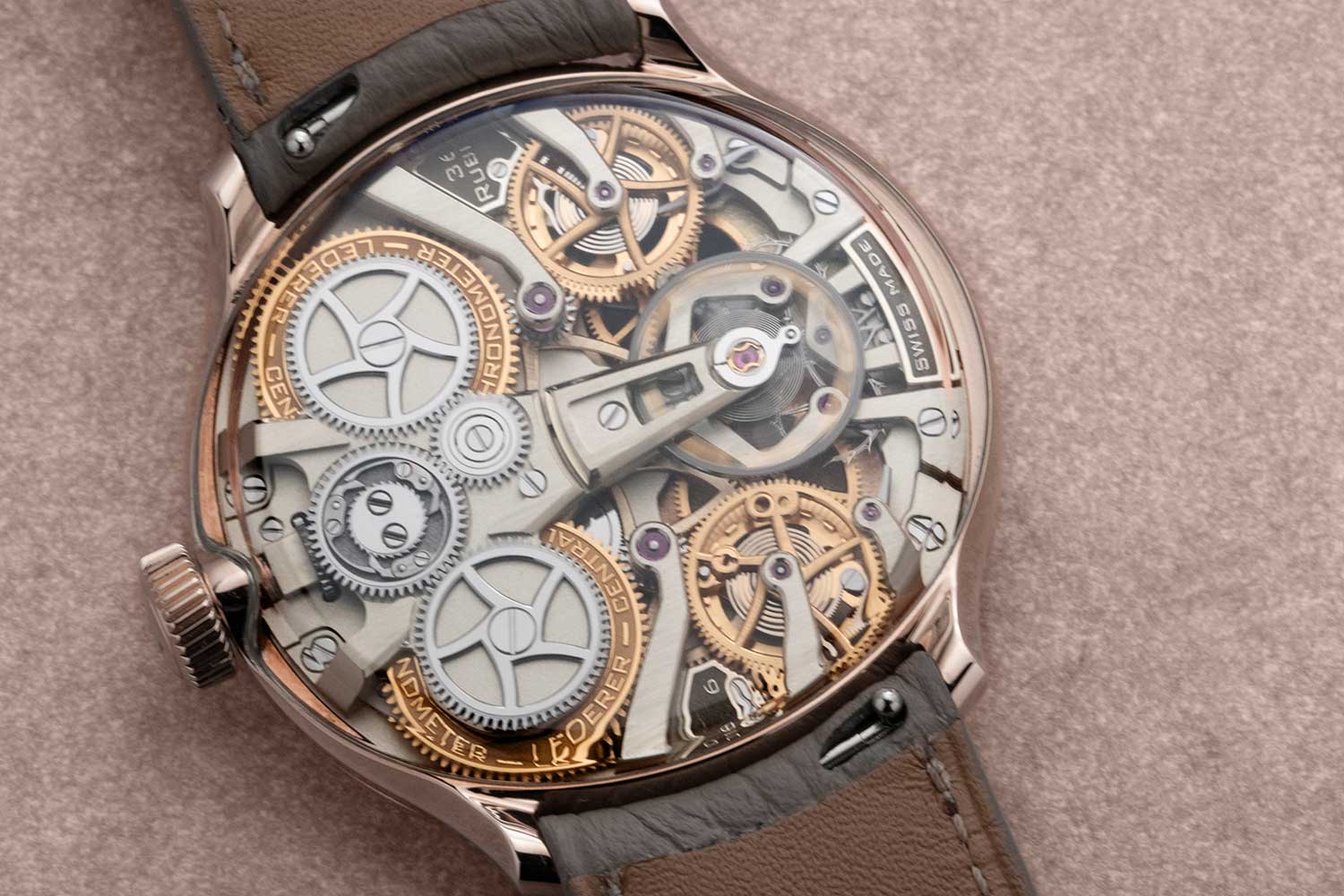
Bernhard Lederer Central Impulse Chronometer 39mm (Image: Revolution©️)
To further reduce the size of the movement, the pair of remontoirs had to be redesigned. To recap in brief, in the original 2021 prototype, each remontoir device consisted of a ratchet stop wheel located on each third wheel. The stop wheel is locked and unlocked by an anchor, to which a jeweled fork is attached. The motion of the fork is in turn controlled by a Reuleaux triangle on the fourth wheel. Each time the Reuleaux triangle turns, it triggers the unlocking of one of the teeth on the remontoir stop wheel through the motion of the anchor.
Later in the production model, Lederer improved the design to reduce friction. He added an additional axle next to the remontoir wheel which features regular cycloidal teeth. On this axle is a stop wheel (a flywheel) that is unlocked every 10 seconds by a semi-circular finger linked to the fork governed by a Reuleaux triangle. The remontoir wheel to stop wheel ratio became 9:1, resulting in negligible frictional effects.
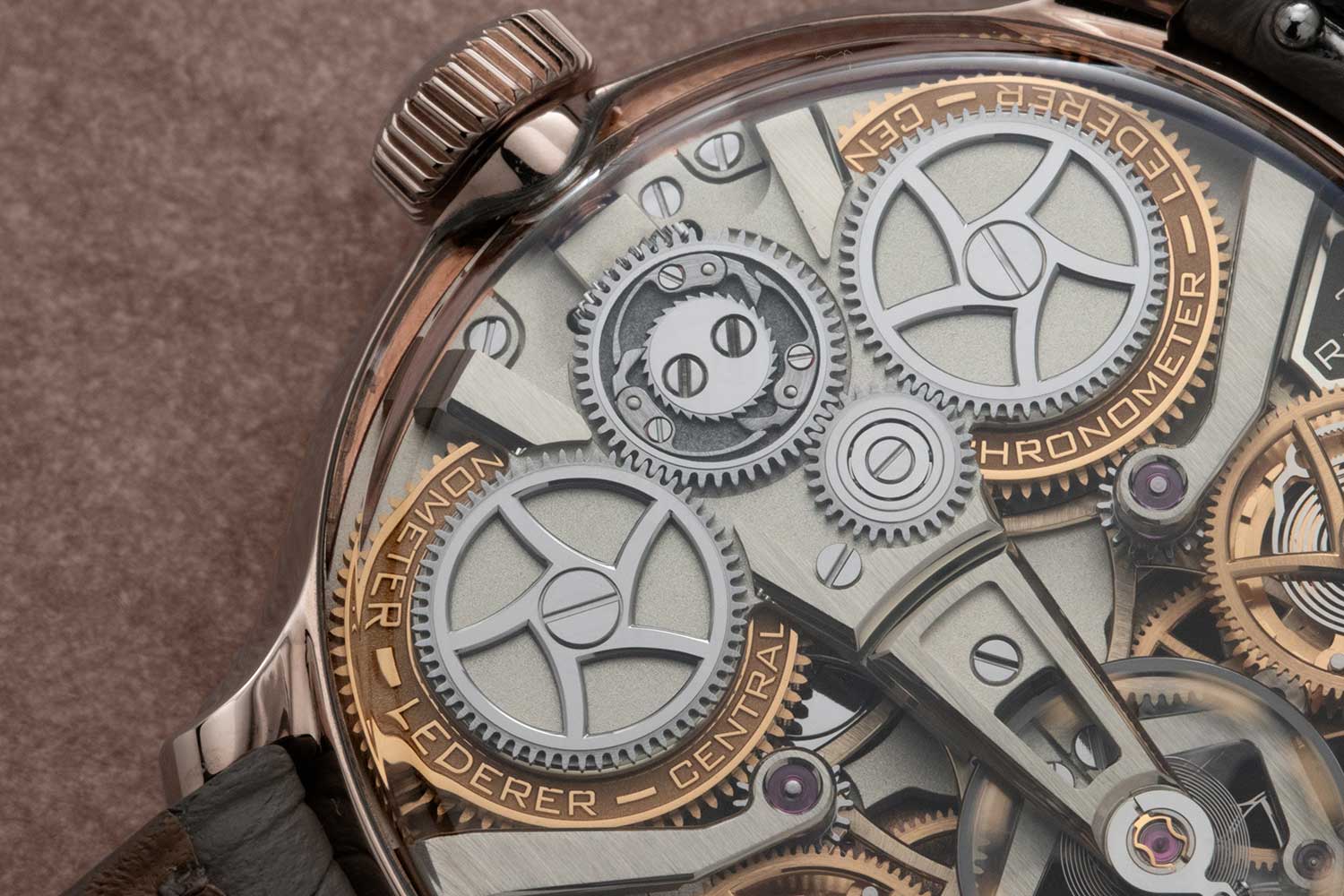
Bernhard Lederer Central Impulse Chronometer 39mm (Image: Revolution©️)
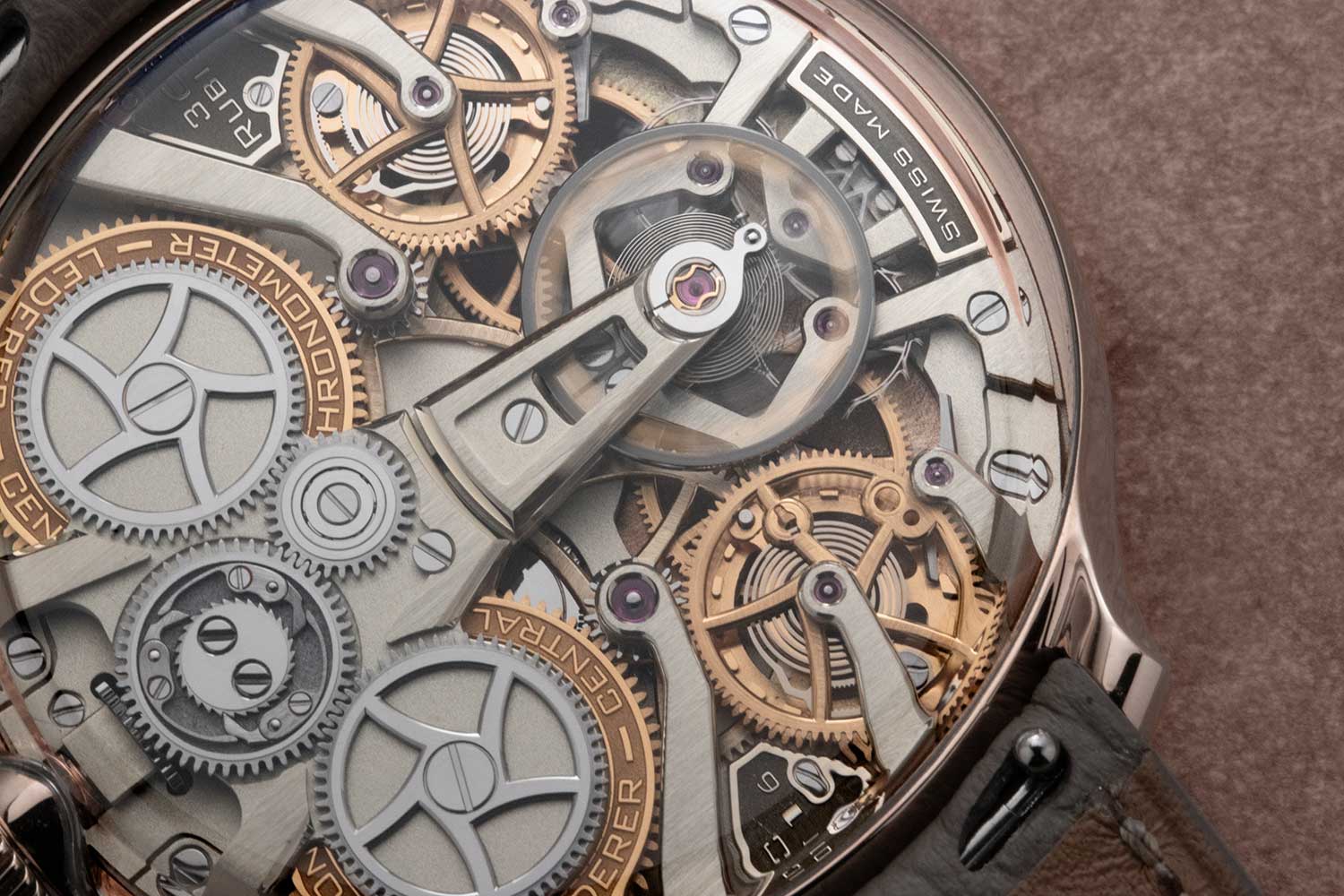
Bernhard Lederer Central Impulse Chronometer 39mm (Image: Revolution©️)
In the new model, the remontoir had to be more compact since the semi-circular finger lies on the edge of the base plate. Therefore, instead of relying on a Reuleaux triangle to control the release of the remontoir, the flywheel is now locked and unlocked by a wheel with vertical pillars underneath the third wheel. The bridges have also been reworked. Originally, the third wheel to which the remontoir spring is attached is supported by an angular traversing bridge which also carries the stop wheel. However, the third wheel and stop wheel are now supported by individual finger bridges. While this serves to minimize the size of the movement, it also gives it a more classical beauty.
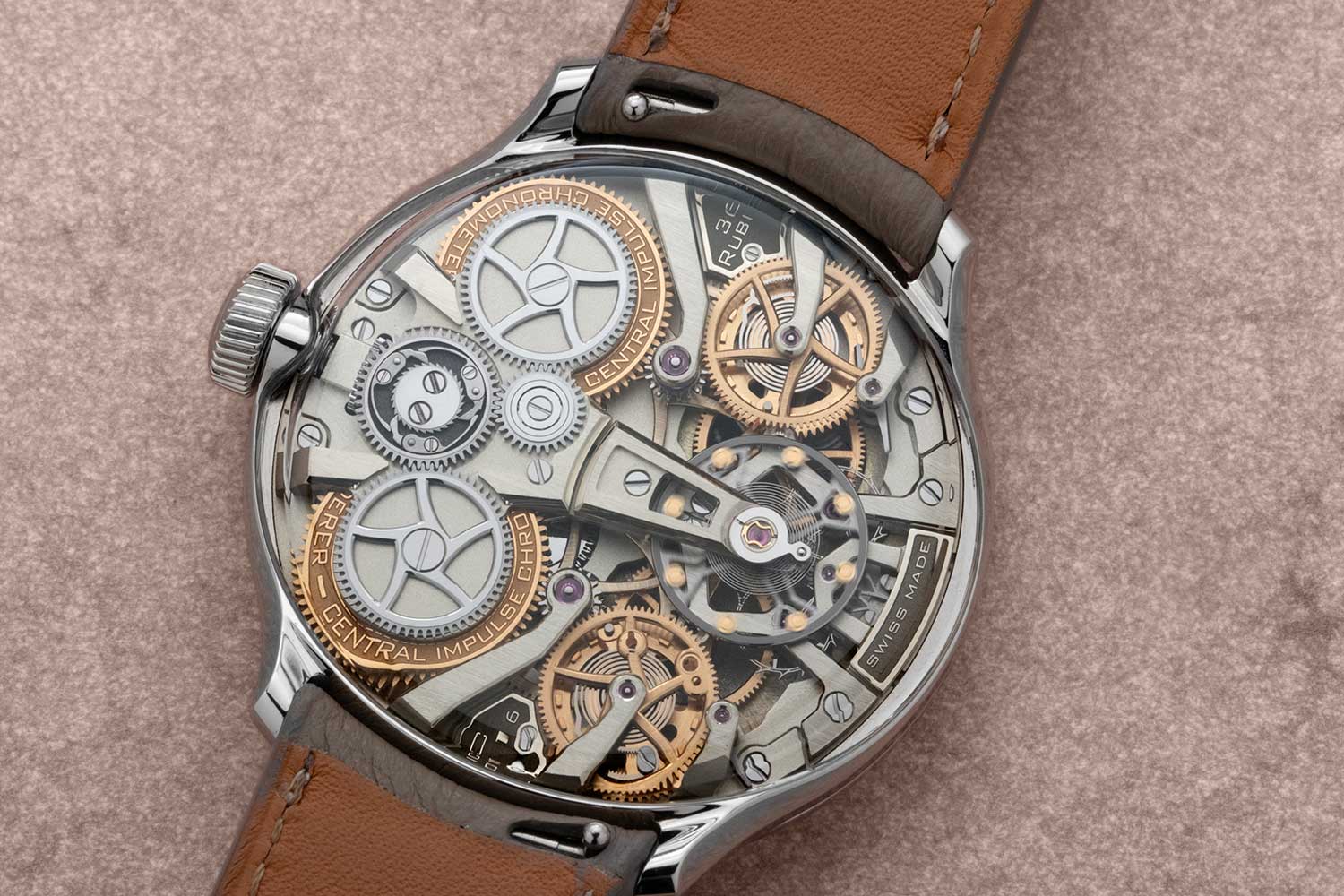
Bernhard Lederer Central Impulse Chronometer 39mm (Image: Revolution©️)
The movement is finished to a very high standard, matching the technical accomplishments of the watch. Most notably, the ratchet wheel along with the wheels of the going train feature unique spokes with prominent anglage and sharp internal angles.
Independent Double Wheel Escapement
The independent double wheel escapement is particularly fascinating as it is theoretically one of the most efficient escapements for a wristwatch. It unique delivers impulses in both directions directly to the balance at each oscillation of the balance wheel, requiring no lubrication. It is self-starting by design due to its bidirectional impulse system, but it requires a fairly large force to drive it from a stationary position, meaning it has to be wound longer.
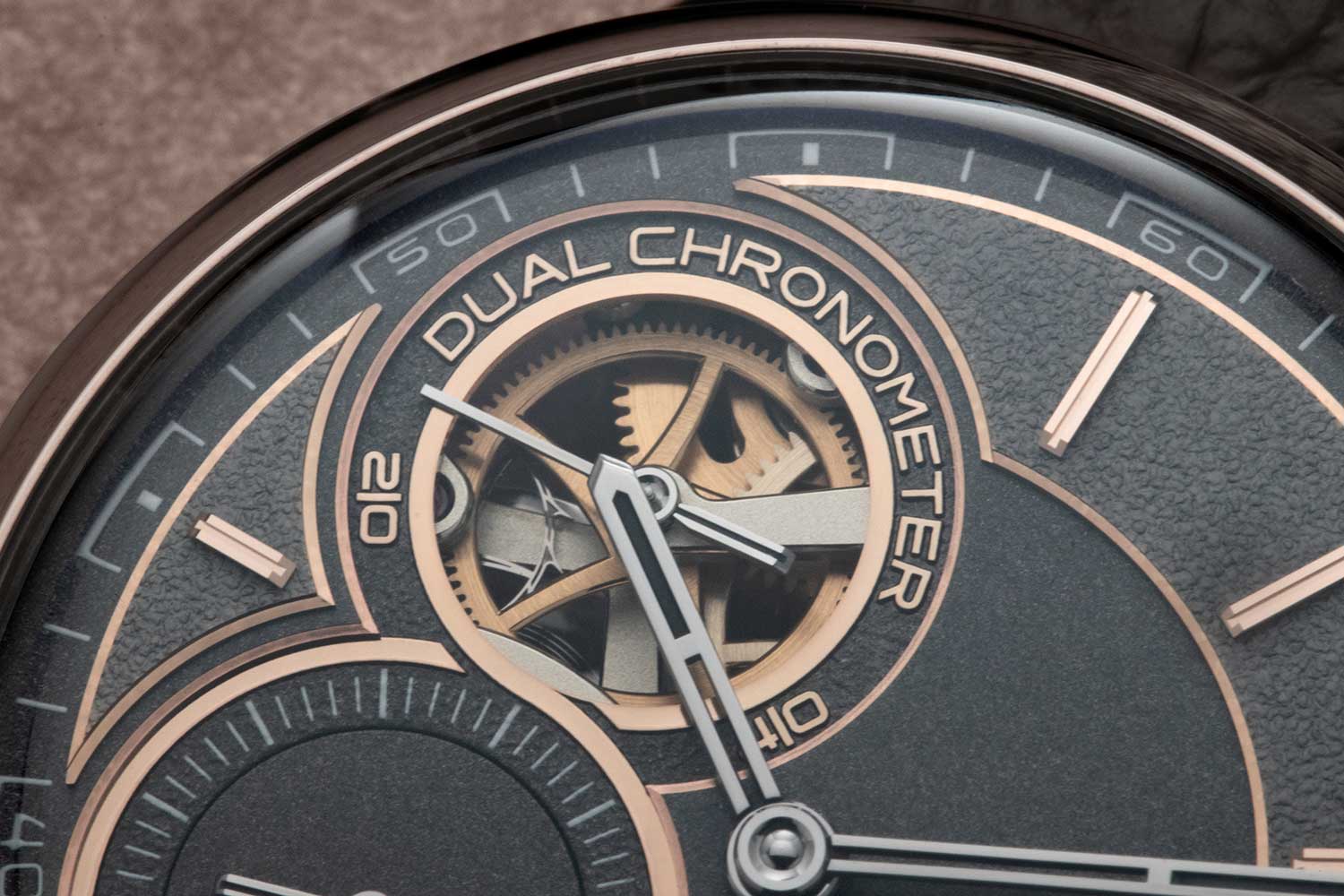
Bernhard Lederer Central Impulse Chronometer 39mm (Image: Revolution©️)
Lederer’s solution was to add two extra impulse surfaces on each side of the principle locking stone to maintain efficiency at low amplitude. At low amplitudes, a tooth of the escape wheel that previously rested on the principal locking stone moves across this tiny sloped surface. As it does, it nudges the detent sideways, prompting a rotation of the double roller. This rotation ensures that the impulse pallet consistently remains positioned in front of the tooth responsible for direct impulse transmission. As such, his version restarts more easily when the watch is wound and does not require significant power. As the balance reaches an amplitude of about 80 degrees, the rotational movement of the detent becomes rapid. At this point, the tooth that was previously in contact with the principal locking stone no longer reaches this additional lateral surface.
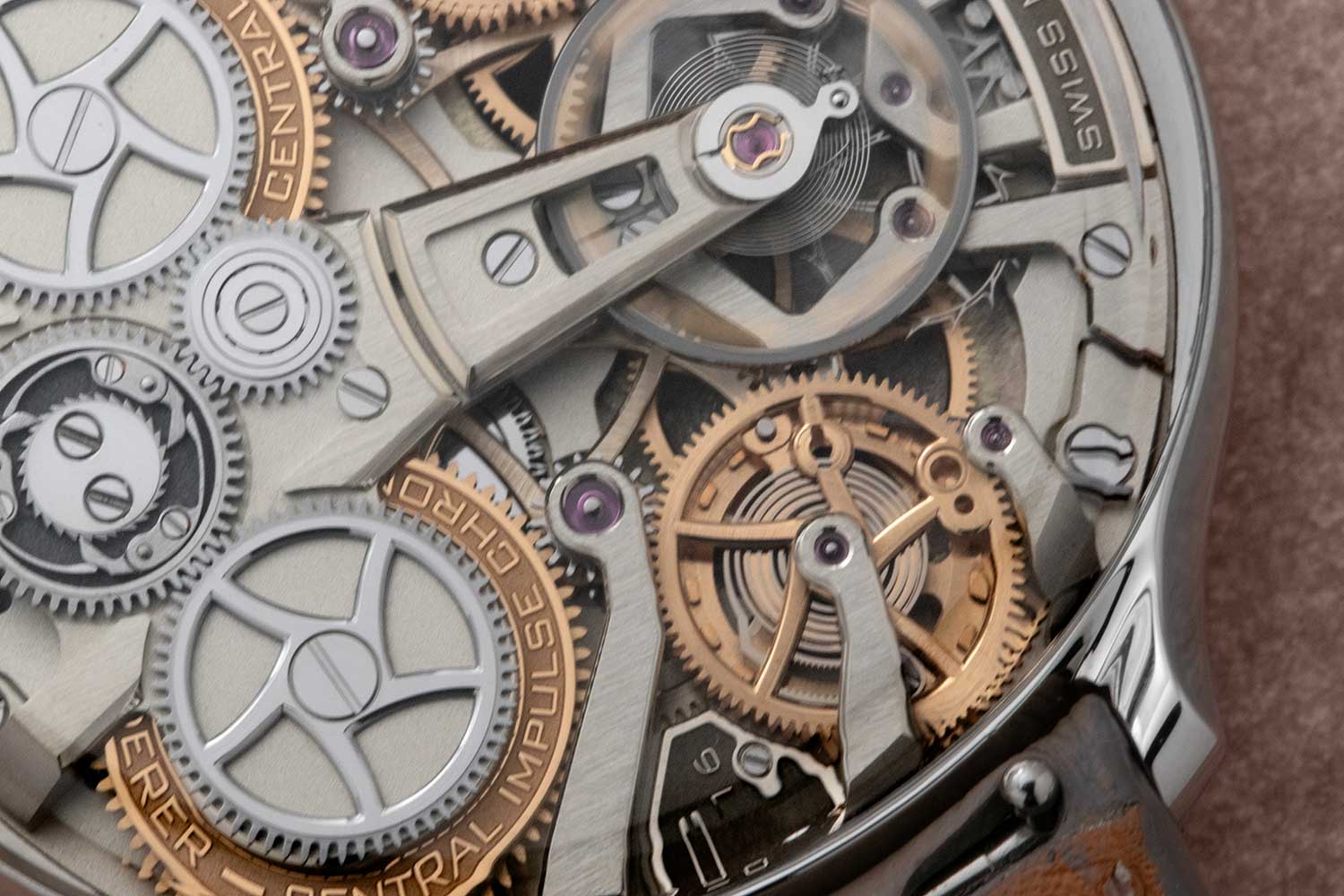
Bernhard Lederer Central Impulse Chronometer 39mm (Image: Revolution©️)
Additionally, in Daniels’ design, the principal locking stone features two sharp edges pointing upward, serving to lock the escape wheel on both sides. This creates a lifting angle that may result in recoil—a backward movement—of the escape wheels upon release from the detent. Lederer addressed this by modifying the shape of the locking stone, removing the upward curve.
To minimise inertia, the twin escape wheels as well as detent lever in Lederer’s escapement are made from titanium, which was chosen for its combination of lightness and strength.

Bernhard Lederer Central Impulse Chronometer 39mm (Image: Revolution©️)
The Central Impulse Chronometer is an incredible feat as it is, but this new 39mm version stands as a remarkable achievement on its own, dispelling the long-held belief that it cannot be miniaturized. Not only has it been reduced in size, but it has been accomplished without concessions, with a pair of remontoirs, a hacking seconds and a more elaborate and refined dial.
Bernhard Lederer Central Impulse Chronometer 39mm
References: CIC 9016.60.302 (white gold, blue dial); CIC 9016.50.303 (rose gold, grey dial)
Movement: Manual winding; 38-hour power reserve; 3 Hz (21,600 vph)
Functions: Hours, minutes and seconds with hacking function
Case: 39mm x 10.75mm; 18K white gold or 18K 5N rose gold; water resistant to 30m
Strap: Black or brown leather, saddle-stitched
Price: CHF 136,800 (excluding VAT)
Availability: Limited to 20 pieces each




